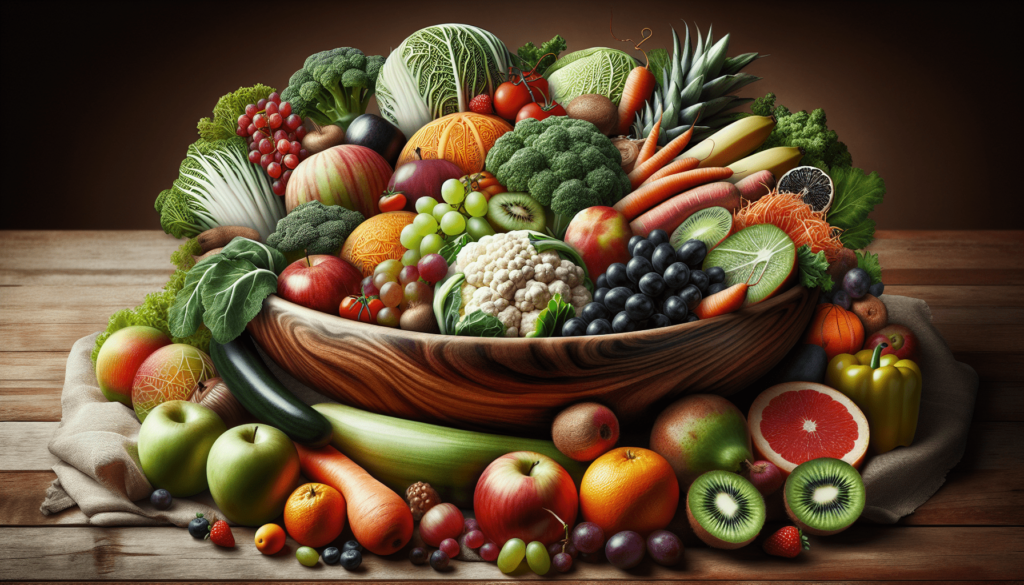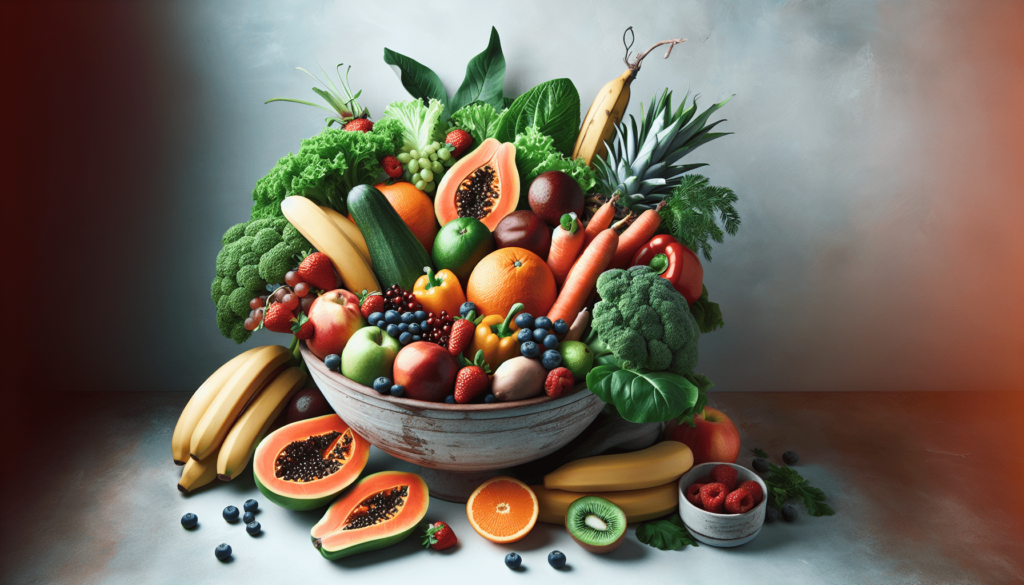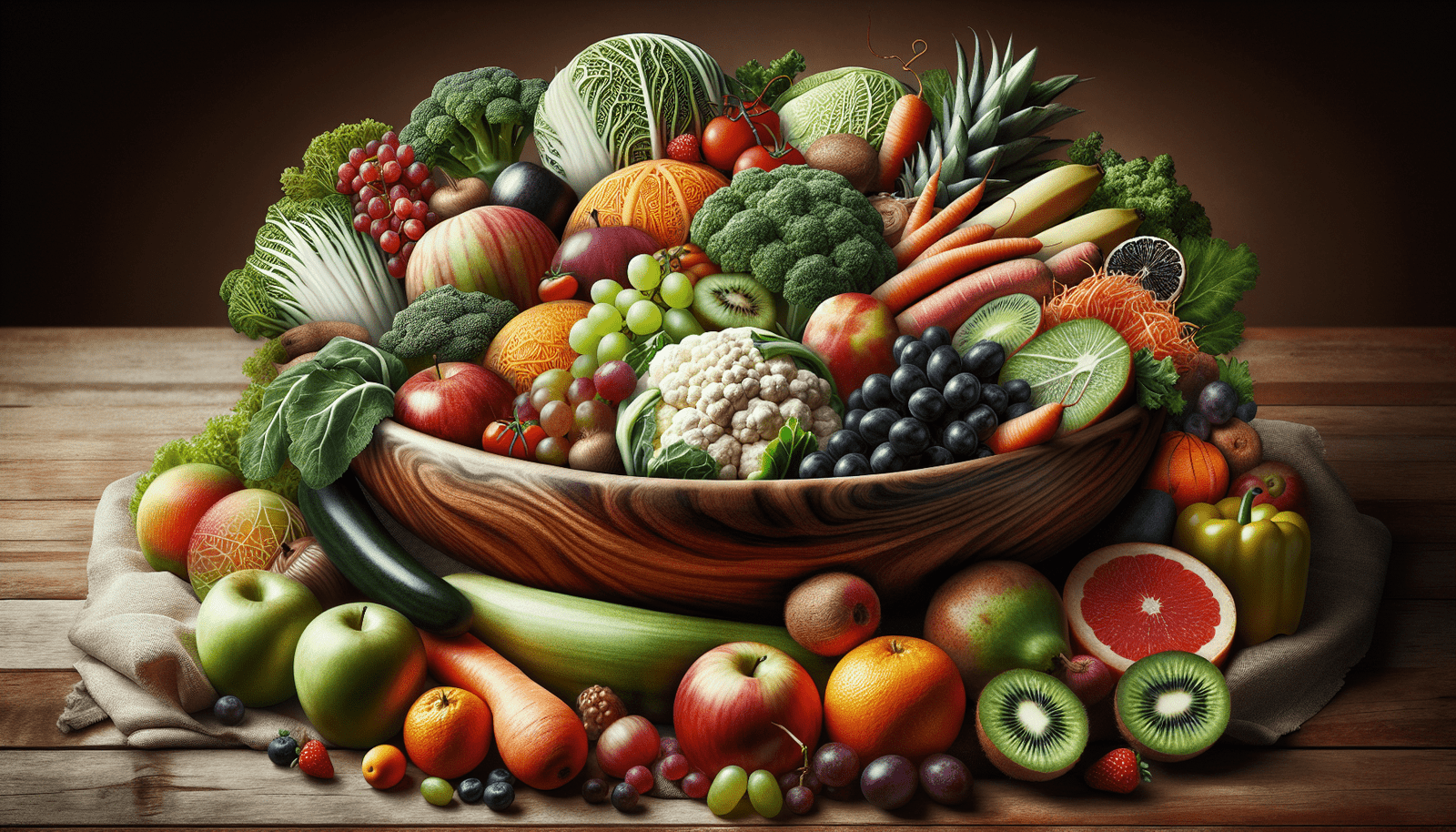So you’ve heard about the trend of going raw and you’re curious to know what it’s all about? Well, look no further! In this article, we will explore the ins and outs of going raw, providing you with valuable insights and information. Whether you’re a health enthusiast or just looking to switch things up in your diet, we’ve got you covered. From the benefits and challenges to tips on getting started, this article will equip you with everything you need to know about going raw. Let’s dig in and uncover the exciting world of raw food!

What is the Raw Food Diet?
The Raw Food Diet is a dietary approach that focuses on the consumption of unprocessed and uncooked foods. The idea behind this diet is that cooking can reduce the nutritional value of food, and by eating foods in their raw and natural state, you can obtain the maximum health benefits. This diet consists primarily of fruits, vegetables, nuts, and seeds, as well as sprouted grains and legumes. The raw food diet can be either a vegetarian or a vegan diet, depending on the individual’s food choices.
Types of Raw Foods
Fruits and Vegetables
Fruits and vegetables form the foundation of the raw food diet. These natural and unprocessed foods are packed with essential vitamins, minerals, and antioxidants. When consumed raw, they provide maximum nutritional value. Fruits such as berries, apples, and citrus fruits, and vegetables like leafy greens, carrots, and cucumbers, are commonly included in a raw food diet.
Nuts and Seeds
Nuts and seeds serve as a great source of healthy fats, protein, and fiber in a raw food diet. Almonds, walnuts, sunflower seeds, and chia seeds are popular choices. They can be eaten raw or lightly toasted to enhance their flavor and texture.
Sprouted Grains and Legumes
Sprouted grains and legumes are germinated or pre-sprouted seeds, which are considered highly nutritious in the raw food diet. They are easier to digest and contain more bioavailable nutrients compared to their cooked counterparts. Examples include sprouted quinoa, lentils, and chickpeas.
Cold-pressed Oils
Cold-pressed oils, such as olive oil and coconut oil, are used sparingly in the raw food diet. These oils undergo minimal processing, preserving their natural nutrients and flavors. They are typically used in dressings or as a drizzle over salads or raw dishes to enhance taste and provide additional healthy fats.
Fermented Foods
Fermented foods play an important role in the raw food diet as they contain beneficial bacteria that support gut health. Examples include sauerkraut, kimchi, and coconut yogurt. These foods are a great source of probiotics and provide a tangy and flavorful addition to meals.
Nutritional Considerations
Macro and Micronutrient Intake
When following a raw food diet, it is essential to ensure a balance of macronutrients (carbohydrates, fats, and protein) and micronutrients (vitamins and minerals). Fruits and vegetables are rich in carbohydrates, nuts and seeds provide healthy fats, and sprouted grains and legumes offer protein. It is important to include a variety of these foods in your diet to meet your nutritional needs.
Protein Sources
Contrary to popular belief, adequate protein intake can be achieved on a raw food diet. Nuts, seeds, sprouted legumes, and certain vegetables like spinach and broccoli are excellent sources of plant-based protein. It is important to include a variety of these protein-rich foods to ensure you are getting a complete range of essential amino acids.
Calcium and Iron Sources
Calcium and iron are two important nutrients that are often a concern with a raw food diet. Calcium can be obtained from leafy greens like kale and collard greens, as well as from nuts and seeds. Iron-rich foods include dark leafy greens, dried fruits, and legumes. Pairing iron-rich foods with a source of Vitamin C, such as citrus fruits or bell peppers, can enhance iron absorption.
Vitamin and Mineral Deficiencies
While the raw food diet offers many nutritional benefits, it is important to be aware of potential deficiencies. Vitamin B12, which is primarily found in animal products, may be lacking in a raw food diet unless supplemented or consumed through fortified foods. Additionally, Vitamin D, iodine, and omega-3 fatty acids may require supplementation or careful attention to dietary choices, especially for those with limited sun exposure.
Supplement Recommendations
Supplements can be a helpful addition to a raw food diet to ensure you are meeting all your nutritional needs. It is advisable to consult with a healthcare professional or registered dietitian who can guide you on specific supplement recommendations based on your individual needs and goals.
Food Preparation and Safety
Washing and Handling Procedures
To minimize the risk of foodborne illnesses, it is crucial to wash fruits, vegetables, and sprouts thoroughly before consuming. Use clean water and gently scrub the produce to remove any dirt or contaminants. It is also important to handle these foods with clean hands and utensils to avoid cross-contamination.
Hygiene Practices
Maintaining proper hygiene practices is essential when following a raw food diet. Wash your hands thoroughly before handling food, especially when preparing meals. Make sure to clean all kitchen surfaces, utensils, and cutting boards after use. Regularly sanitize equipment, such as blenders or food processors, to prevent the growth of harmful bacteria.
Food Storage Recommendations
Storing raw foods properly helps to maintain their freshness and minimize the risk of spoilage. Keep fruits and vegetables in the refrigerator, preferably in airtight containers or bags, to prolong their shelf life. Nuts and seeds can be stored in the refrigerator or freezer to prevent them from going rancid. It is important to regularly inspect your stored foods for any signs of spoilage and discard them if necessary.
Potential Risks of Consuming Raw Foods
While raw foods can be highly nutritious, certain foods, such as raw eggs or unpasteurized milk, pose a risk of foodborne illnesses. It is important to be cautious when choosing raw food ingredients and to ensure they come from reputable sources. Pregnant women, young children, the elderly, and individuals with compromised immune systems should be particularly vigilant in avoiding potential risks.
Foodborne Illness Prevention
To prevent foodborne illnesses when consuming raw foods, it is crucial to implement good food safety practices. This includes avoiding cross-contamination between raw and cooked foods, refrigerating perishable foods promptly, and cooking foods to safe internal temperatures when incorporating cooked foods into your diet.

Transitioning to a Raw Food Diet
Gradual versus Immediate Transition
Transitioning to a raw food diet can be done gradually or immediately, depending on personal preference and the ability to adapt to dietary changes. Gradual transition involves slowly incorporating more raw foods into your meals while gradually reducing the intake of cooked and processed foods. Immediate transition involves completely cutting out cooked and processed foods from your diet and diving straight into a fully raw food lifestyle. Choose the approach that feels most manageable and sustainable for you.
Tips for a Successful Transition
To successfully transition to a raw food diet, it is important to plan and prepare ahead of time. Start by educating yourself about the raw food diet and the various recipes and meal ideas available. Stock up on fresh produce, nuts, seeds, and other raw food staples. Experiment with different flavors and textures to find what you enjoy most. Stay hydrated and listen to your body’s cues to ensure you are meeting your nutritional needs.
Overcoming Challenges and Cravings
Transitioning to a raw food diet may come with its own set of challenges and cravings, especially if you are accustomed to cooked and processed foods. It can be helpful to find healthy alternatives or raw versions of your favorite cooked dishes to satisfy cravings. Exploring new recipes, spices, and seasoning techniques can also add variety and excitement to your raw food meals.
Meal Planning and Recipe Resources
Planning your meals and having a well-stocked pantry are key to success on a raw food diet. Look for recipe resources, such as cookbooks and online blogs, that specialize in raw food recipes. Experiment with different flavors, textures, and combinations to keep your meals exciting and enjoyable. Consider meal prepping and batch cooking to make the transition easier and more convenient.
Support and Community
Seeking support from like-minded individuals can be beneficial during your transition to a raw food diet. Join online communities or local raw food groups to connect with others who share similar goals and challenges. Being part of a supportive community can provide motivation, inspiration, and a platform to share tips and experiences.
Health Benefits of Going Raw
Weight Loss and Management
One of the major benefits of the raw food diet is weight loss and management. Raw foods are typically lower in calories and higher in fiber, which can help promote satiety and control cravings. Additionally, raw foods are nutrient-dense, which means you can eat a larger volume of food while still consuming fewer calories.
Improved Digestion and Gut Health
The raw food diet is rich in fiber, which aids in digestion and promotes a healthy gut. Raw fruits, vegetables, and sprouted foods contain enzymes that can support proper digestion and nutrient absorption. The high water content in raw foods also helps prevent constipation and keeps the digestive system functioning optimally.
Increased Energy and Vitality
Many individuals report experiencing increased energy and vitality when following a raw food diet. Raw foods are packed with nutrients, antioxidants, and enzymes that can provide a natural energy boost. By avoiding processed and refined foods, which can cause energy crashes and fatigue, the raw food diet can help improve overall energy levels.
Enhanced Immune Function
The nutrient-rich nature of the raw food diet can support a strong immune system. The abundance of vitamins, minerals, and antioxidants in raw foods helps to strengthen the body’s defenses against infections and illnesses. Additionally, the inclusion of fermented foods in the raw food diet can promote a healthy balance of gut bacteria, which plays a vital role in immune function.
Reduced Risk of Chronic Diseases
A well-balanced raw food diet, rich in fruits, vegetables, and whole foods, can contribute to a reduced risk of chronic diseases. The high intake of antioxidants and phytonutrients in raw foods helps to combat inflammation and oxidative stress, which are key factors in the development of chronic diseases such as heart disease, diabetes, and certain types of cancer.
Potential Drawbacks of Going Raw
Digestive Challenges
Some individuals may experience digestive challenges when transitioning to a raw food diet. The high fiber content of raw foods can cause bloating, gas, and changes in bowel movements. It is important to gradually increase fiber intake and ensure proper hydration to support healthy digestion. Also, the raw food diet may not be suitable for individuals with digestive disorders or sensitivities to certain raw foods.
Social and Practical Limitations
Following a raw food diet may present social and practical limitations, especially in situations where cooked food is the norm. Dining out or attending social events may require more planning and preparation to ensure there are suitable raw food options available. It is important to communicate your dietary needs with friends, family, and restaurants to ensure a pleasant and inclusive dining experience.
Difficulty Obtaining Adequate Nutrients
Ensuring adequate nutrient intake on a raw food diet can be challenging, especially for certain nutrients that are commonly found in cooked or fortified foods. As mentioned earlier, Vitamin B12, Vitamin D, iodine, and omega-3 fatty acids may require extra attention or supplementation. It is important to be knowledgeable about raw food sources of essential nutrients and make informed choices to avoid nutritional deficiencies.
Time-Consuming Food Preparation
Preparing raw food meals can be more time-consuming compared to cooking. Raw foods often involve more chopping, blending, and marinating, which may require additional time and effort in the kitchen. It is important to plan meals and make use of time-saving techniques, such as batch cooking or prepping ingredients in advance, to minimize the time required for food preparation.
Need for Variety and Creativity
To maintain a raw food diet long-term, variety and creativity are essential. Eating the same raw foods repeatedly can become monotonous and may lead to a lack of motivation or enjoyment. Exploring new recipes, flavors, and textures can help keep meals exciting and satisfying. Being open to trying different fruits, vegetables, nuts, seeds, and spices can also increase the nutritional diversity of your diet.
Balancing a Raw Food Diet
Incorporating Cooked Foods
Incorporating some cooked foods into a raw food diet can help address certain nutritional concerns and increase dietary flexibility. This can include steaming vegetables, lightly sautéing greens, or consuming cooked whole grains sparingly. It is important to listen to your body’s needs and find the right balance that works for you.
Finding the Right Balance for Your Body
Finding the right balance on a raw food diet is highly individualized. Some individuals may thrive on a fully raw diet, while others may feel their best with a combination of raw and cooked foods. Experimentation and self-reflection are key to discovering what makes you feel energized, nourished, and satisfied.
Understanding Personal Preferences and Needs
Understanding your personal preferences and needs is crucial when following a raw food diet. Every individual is unique, and it is important to consider factors such as taste preferences, food tolerances, and specific health conditions. Listening to your body, being aware of how different foods make you feel, and seeking professional guidance can help you tailor the raw food diet to your specific needs.
Seeking Professional Guidance
If you are considering a raw food diet or have any concerns about meeting your nutritional needs, it is advisable to consult with a healthcare professional or registered dietitian. They can help assess your current dietary habits, provide personalized guidance and recommendations, and monitor your health and nutrient status.
Listening to Your Body’s Cues
Lastly, listening to your body’s cues is essential in maintaining a balanced and healthy approach to a raw food diet. Pay attention to hunger and fullness signals, energy levels, and overall well-being. Adjust your food choices as needed to ensure you are meeting your nutrient requirements and supporting your body’s unique needs.
Common Misconceptions About Raw Food
Raw Food Diet as a ‘One-Size-Fits-All’ Approach
One common misconception about the raw food diet is that it is a ‘one-size-fits-all’ approach that works for everyone. However, each individual has different nutritional needs, health conditions, and tolerances. While the raw food diet may be beneficial for some, it may not be suitable for others. It is important to consider individual variations and make decisions based on personal needs and preferences.
Belief That All Cooked Foods Are Unhealthy
Another misconception is the belief that all cooked foods are unhealthy. While it is true that cooking can reduce the nutrient content of certain foods, it can also enhance the bioavailability of certain nutrients. Some foods, such as tomatoes and carrots, release more antioxidants when cooked. It is important to strike a balance between raw and cooked foods to optimize nutrient intake and variety.
Assumption That All Raw Foods Are Safe to Consume
Not all raw foods are safe to consume. Some raw foods, such as raw eggs or unpasteurized milk, carry a risk of foodborne illnesses. It is essential to choose raw food ingredients carefully, ensuring they are sourced from reputable suppliers and appropriately handled and stored. Being aware of potential risks and adopting proper food safety practices can help mitigate any health concerns.
Misunderstanding of Nutrient Bioavailability
There is often a misunderstanding about nutrient bioavailability in raw foods. While raw foods are rich in many nutrients, some may be less bioavailable in their raw form. Cooking can enhance the availability of certain nutrients, such as lycopene in tomatoes or beta-carotene in carrots. Understanding how cooking affects nutrient bioavailability can help you make informed choices and maximize your nutrient intake.
Myths and Misinformation About Weight Loss
There are various myths and misinformation surrounding weight loss on a raw food diet. While the raw food diet can support weight loss due to its high fiber and nutrient content, it is not a magic solution for shedding pounds. Like any other dietary approach, weight loss requires a holistic approach that includes a balanced diet, regular physical activity, and overall lifestyle factors.
Conclusion
In conclusion, the raw food diet is a dietary approach that focuses on consuming unprocessed and uncooked foods. It includes a wide range of fruits, vegetables, nuts, seeds, sprouted grains, legumes, cold-pressed oils, and fermented foods. While there are potential benefits to this diet, such as weight loss, improved digestion, increased energy, enhanced immune function, and reduced risk of chronic diseases, it is important to consider the potential drawbacks and nutritional considerations.
When transitioning to a raw food diet, gradual or immediate approaches can be taken. Planning, support, and creativity in meal preparation are essential for success. It is important to balance a raw food diet by incorporating cooked foods if needed, finding the right balance for your body, and listening to your body’s cues. Seeking professional guidance and debunking common misconceptions can further support a balanced and healthy approach to the raw food diet.
Before starting a raw food diet, it is crucial to thoroughly research, consider personal preferences and needs, and consult with a healthcare professional or registered dietitian. Ensuring a balanced and varied intake of nutrients, adopting proper food preparation and safety practices, and being mindful of potential risks will contribute to a sustainable and health-conscious raw food lifestyle.

